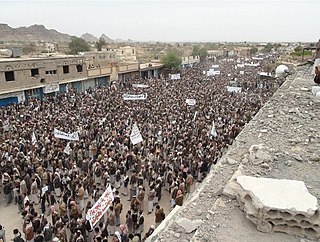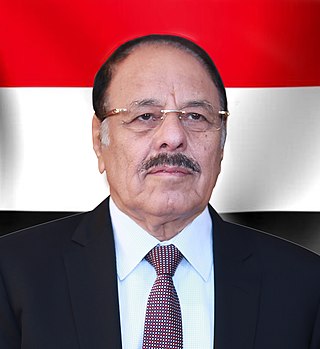
The Yemeni Armed Forces are the military forces of the Republic of Yemen. They include the Yemeni Army, Yemeni Navy and the Yemeni Air Force. The capital of the country, Sana’a is where the military is headquartered. Per the constitution of Yemen, the President of Yemen serves as the commander-in-chief.

The Hashid is a tribal confederation in Yemen. It is the second or third largest – after Bakil and, depending on sources, Madh'hij – yet generally recognized as the strongest and most influential. According to medieval Yemeni genealogies, Hashid and Bakil were the sons of Jashim bin Jubran bin Nawf Bin Tuba'a bin Zayd bin Amr bin Hamdan. Member tribes of the Hashid Confederation are found primarily in the mountains in the North and Northwest of the country.

The modern history of Yemen began with the withdrawal of the Ottoman Empire. In 1839 the British set up a protective area around the southern port of Aden and in 1918 the northern Kingdom of Yemen gained independence from the Ottoman Empire. North Yemen became a republic in 1962, but it was not until 1967 that the British Empire withdrew from what became South Yemen. In 1970, the southern government adopted a communist governmental system. The two countries were officially united as the Republic of Yemen on May 22, 1990.

Sheikh Abdullah bin Husayn bin Nasser al-Ahmar was a Yemeni politician and tribal leader. He was the Speaker of the House of Representatives (Yemen) from 1993 to 2007 and also was the Sheikh of the Hashid tribal federation and the Al-Islah party.

Banu Hamdan is an ancient, large, and prominent Arab tribe in northern Yemen.

The Battle of Saada was a military confrontation that erupted in March 2011 between Houthi rebels and tribal forces loyal to Yemeni President Ali Abdullah Saleh in the northern city of Saada. Following days of heavy clashes, the Houthis managed to capture the entire Saada Governorate including its provincial capital and established an independent administration, thereby marking the first such Yemeni governorate to fall out of central government control since the nationwide uprising began in 2011. Saada later becomes known as the Houthi stronghold since its takeover.

The Yemeni revolution followed the initial stages of the Tunisian Revolution and occurred simultaneously with the 2011 Egyptian revolution and other Arab Spring protests in the Middle East and North Africa. In its early phase, protests in Yemen were initially against unemployment, economic conditions and corruption, as well as against the government's proposals to modify Yemen's constitution. The protesters' demands then escalated to calls for the resignation of Yemeni President Ali Abdullah Saleh. Mass defections from the military, as well as from Saleh's government, effectively rendered much of the country outside of the government's control, and protesters vowed to defy its authority.

Ali Mohsen Saleh al-Ahmar, sometimes spelled Muhsin, is a Yemeni military officer who served as the vice president of Yemen from 2016 to 2022, when he was dismissed by President Abdrabbuh Mansur Hadi, who transferred the powers of the president and vice president to the Presidential Leadership Council. He is a general in the Yemeni Army and was the commander of the northwestern military district and the 1st Armoured Division. He played a leading role in the creation of the General People's Congress.
Hamid bin Abdullah bin Hussein al-Ahmar is a Yemeni politician currently living in exile alongside the rest of the Sunni politicians that fled Yemen during the Houthi takeover of Sana'a September 2014. He is the former general secretary of the Preparatory Committee of the National Dialogue for the JMP and a member of opposition party Yemeni Congregation for Reform, commonly known as Islah.

The Battle of Sanaa was a battle during the 2011 Yemeni uprising between forces loyal to Yemeni leader Ali Abdullah Saleh and opposition tribal forces led by Sheikh Sadiq al-Ahmar for control of the Yemeni capital Sanaa and, on the part of the opposition, for the purpose of the downfall of president Saleh.

The following is a timeline of the 2011 Yemeni revolution from January to 2 June 2011. The Yemeni revolution was a series of major protests, political tensions, and armed clashes taking place in Yemen, which began in January 2011, influenced by concurrent protests in the region. Hundreds of protesters, members of armed groups, army soldiers and security personnel were killed, and many more injured, in the largest protests to take place in the South Arabian country for decades.

Sheikh Sadiq bin Abdullah bin Hussein bin Nasser al-Ahmar was a Yemeni politician and the leader of the Hashid tribal federation. He succeeded his father Abdullah ibn Husayn al-Ahmar in these positions after Abdullah's death in 2007. He is best known for his role in the 2011 Yemeni uprising, in which fighters under his command attacked and seized government facilities in the Battle of Sana'a.

The following is a timeline of the 2011–2012 Yemeni revolution from 3 June through 22 September 2011. The Yemeni revolution was a series of major protests, political tensions, and armed clashes taking place in Yemen, which began in January 2011 and were influenced by concurrent protests in the region. Hundreds of protesters, members of armed groups, army soldiers and security personnel were killed, and many more injured, in the largest protests to take place in the South Arabian country for decades.

The following is a timeline of the 2011–2012 Yemeni revolution from 23 September through December 2011. The Yemeni revolution was a series of major protests, political tensions, and armed clashes taking place in Yemen, which began in January 2011 and were influenced by concurrent protests in the region. Hundreds of protesters, members of armed groups, army soldiers and security personnel were killed, and many more injured, in the largest protests to take place in the South Arabian country for decades.

The siege of Dammaj began in October 2011 when the Houthis, a Zaydi-led rebel group which controls the Sa'dah Governorate, accused Salafis loyal to the Yemeni government of smuggling weapons into their religious center in the town of Dammaj and demanded they hand over their weapons and military posts in the town. As the Salafis refused, Houthi rebels responded by imposing a siege on Dammaj, closing the main entrances leading to the town. The town was controlled by the Houthis and the fighting was mainly centered at Dar al-Hadith religious school, which was operated by Salafis.

The following is a timeline of the 2011–2012 Yemeni revolution from January to 27 February 2012. The Yemeni revolution was a series of major protests, political tensions, and armed clashes taking place in Yemen, which began in January 2011 and were influenced by concurrent protests in the region. Hundreds of protesters, members of armed groups, army soldiers and security personnel were killed, and many more injured, in the largest protests to take place in the South Arabian country for decades.

The Lahij insurgency was a guerrilla war in 2015 waged by tribesmen loyal to Abdrabbuh Mansur Hadi against the Houthis and Yemen Army units loyal to Ali Abdullah Saleh, who controlled most of the Lahij Governorate of Yemen. In late July, Pro-Hadi forces had launched an offensive to recapture Al Anad Air Base and rest of Lahij Governorate. On 4 August, Pro-Hadi forces had retaken full control of the Lahij Governorate.

The Nihm Offensive was a military operation that began in mid-December 2015 in the District of Nihm, when government forces took control of "Mas camp" which borders the governorates of Al-Jawf, and Marib. On 19–20 December, government forces coming from Marib and al-Jawf, took control of the 312th Armored Brigade camp, and 334th Armored Brigade camp. Government forces faced fierce resistance that lasted until February 2016, when they were able to take control of the 312th Armored Corps camp.

The following outline is provided as an overview of and topical guide to the Wikipedia articles available about the Yemeni crisis, revolution, and Yemeni civil war (2014–present).

The Tribes of Yemen are the tribes residing within the borders of the Republic of Yemen. There are no official statistics, but some studies indicate that tribes constitute about 85% of the population of 25,408,288 as of February 2013. According to some statistics, there are approximately 200 tribes in Yemen, and some counted more than 400 tribes. Yemen stands out as the most tribal nation in the Arab world due to the significant influence wielded by tribal leaders and their deep integration into the various facets of the state.














